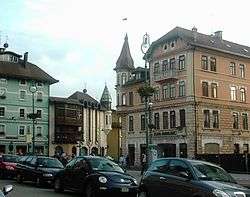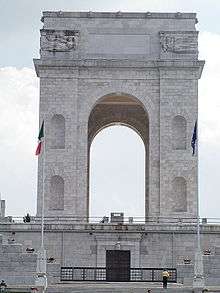Asiago
| Asiago Slege | |
|---|---|
| Comune | |
| Comune di Asiago | |
 | |
 Asiago Location of Asiago in Italy | |
| Coordinates: 45°52′N 11°31′E / 45.867°N 11.517°ECoordinates: 45°52′N 11°31′E / 45.867°N 11.517°E | |
| Country | Italy |
| Region | Veneto |
| Province / Metropolitan city | Vicenza (VI) |
| Frazioni | Sasso |
| Government | |
| • Mayor | Roberto Rigoni Stern |
| Area | |
| • Total | 162 km2 (63 sq mi) |
| Elevation | 1,001 m (3,284 ft) |
| Population (31 December 2014)[1] | |
| • Total | 6,462 |
| • Density | 40/km2 (100/sq mi) |
| Demonym(s) | Asiaghesi / Slegar |
| Time zone | CET (UTC+1) |
| • Summer (DST) | CEST (UTC+2) |
| Postal code | 36012 |
| Dialing code | 0424 |
| Patron saint | St. Matthew |
| Saint day | 21 September |
| Website | Official website |
Asiago (Italian: [aˈzjaːɡo]; Cimbrian: Slege, German: Schlägen [ˈʃlɛːɡn̩]) is the name of both a major Italian PDO (Protected Designation of Origin) cheese and a minor township (population roughly 6,500) in the surrounding plateau region (the Altopiano di Asiago or Altopiano dei Sette Comuni, Asiago plateau) in the Province of Vicenza in the Veneto region of Northeastern Italy. It is near the border between the Veneto and Trentino-Alto Adige/Südtirol regions in the foothills of the Alps, and about equidistant (60 km) from the major cities of Trento to the west and Vicenza to the south.

The Asiago region is the origin of Asiago cheese. The town was the site of a major battle between Austrian and Italian forces on the Alpine Front of World War I. It is a major ski resort destination as well as the site of the Astrophysical Observatory of Asiago, operated by the University of Padua.
Culture
Until the middle of the nineteenth century many of the people of Asiago spoke Cimbrian, an ancient German dialect.
Asiago is the birthplace of author Mario Rigoni Stern, and features prominently in his stories. It is also described in Emilio Lussu's A Year on the Altopiano.
Battle of Asiago
The Battle of Asiago (Battle of the Plateaux) was a counter-offensive launched by the Austro-Hungarians on the Italian Front in May 1916, during World War I. It was an unexpected attack that took place near Asiago (now in northeast Italy, then on the Italian side of the border between the Kingdom of Italy and Austria-Hungary). Commemorating this battle and the fallen soldiers of World War I is the Asiago War Memorial, a monument and museum that is a popular site for visitors to the area.[2]
Ernest Hemingway fought here. In a later engagement in 1918, Edward Brittain, brother of Vera Brittain, was killed and was buried in the Granezza British military cemetery on the plateau. In 1970 Vera's ashes were scattered on his grave.
Sport
The city is home to HC Asiago, a professional ice hockey team currently playing in the country's top division, Serie A1.
The Asiago Vipers, also based in Asiago, are a professional inline hockey team. The team plays in the highest Italian inline league.
- Aldo Stella, ski mountaineer and cross-country skier.
- Enrico Fabris, long track speed skater who has won three World Cup races.
- Lucio Topatigh, Italian ice hockey legend.
- Ivan Lunardi, one of the best Italian ski jumpers in history.
References
- ↑ All demographics and other statistics from the Italian statistical institute (Istat)
- ↑ "Sacrario militare di Asiago-Leiten e museo del Sacrario" (in Italian). Itinerari della Grande Guerra. Retrieved 24 April 2013.
External links
- Official site (Italian)
- Asiago plateau (Italian) (English) (German)
- Asiago7Comuni news and general information (Italian)
- General information (English)
- Battle of Asiago (English)
- Astrophysical Observatory of Asiago (English)
- Asiago on The Campanile Project